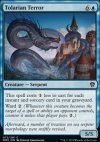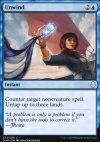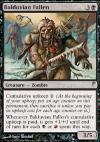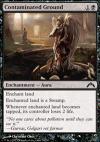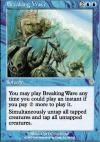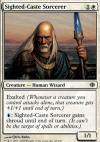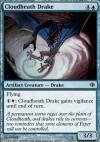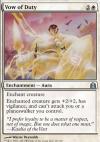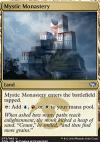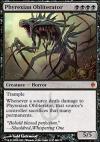|

MV anecdotes
| 1028 anecdotes trouvées |   |
Les dix cartes Cephalopod Sentry, Voidwing Hybrid, Charforger, Cinderslash Ravager, Slaughter Singer, Vivisection Evangelist, Serum-Core Chimera, Necrogen Rotpriest, Bladehold War-Whip et Tainted Observer, de l'édition Phyrexia: All Will Be One, forment un cycle de permanents bicolores peu communs soutenant chacun un archétype de formats limités.
Source 1 (Rogue ONE - "Here's how the ten two-color archetypes ended up") - Source 2 ("Draft, as an example, had a big influence on the uncommon gold cards that model Draft archetypes")
Source 1 (Rogue ONE - "Here's how the ten two-color archetypes ended up") - Source 2 ("Draft, as an example, had a big influence on the uncommon gold cards that model Draft archetypes")
Citation :
Here's how the ten two-color archetypes ended up:
White-blue (artifacts) – The Phyrexians have always been tied to artifacts, so it only seemed right to have one draft archetype focus on them. Blue is primary in "artifact matters" and white is secondary, so those two colors seemed like the best choices.
Blue-black (proliferate control) – Blue is one of oil counter colors. Black is one of the poison counter colors. Put the two of them together, and you have your normal manipulative blue-black deck, but now with a dose of counters and proliferate.
Black-red (oil counters and sacrifice) – Sacrifice is a common black-red archetype. The set adds in oil counters to the mix and creates a two-color combination that feels quite Phyrexian, as they see death as a valuable tool.
Red-green (midrange oil counters) – Red and green are both oil counter colors and are the two colors that care most about how many permanents you have with oil counters. This theme works well with a deck that grows in strength over time as you gain in mana and oil counters.
Green-white (toxic aggro) – Green and white are two of the three poison colors. This deck makes a horde of creatures with toxic, including the Mite creature tokens, and swarms for a poison win.
White-black (corrupted) – White and black are the two colors with the most corrupted cards, so they come together to poison your opponent just enough to make your cards even more powerful.
Blue-red (oil counters and noncreature spells) – This deck uses your noncreature spells to gain more and more oil counters, which then create effects to help you win this tempo strategy.
Black-green (poison victory) – Black and green are the two colors with the largest toxic creatures. Get them out and win in just a few hits.
Red-white (For Mirrodin! Equipment) – Red and white are the two colors with the most Rebels in it. Use the Equipment with the For Mirrodin! keyword to aggressively attack.
Green-blue (proliferate and poison) – Green has a lot of cards that poison. Blue and green are both good at proliferating. Poison your opponent and then slowly proliferate them to death. This is the most controlling of the poison decks.
White-blue (artifacts) – The Phyrexians have always been tied to artifacts, so it only seemed right to have one draft archetype focus on them. Blue is primary in "artifact matters" and white is secondary, so those two colors seemed like the best choices.
Blue-black (proliferate control) – Blue is one of oil counter colors. Black is one of the poison counter colors. Put the two of them together, and you have your normal manipulative blue-black deck, but now with a dose of counters and proliferate.
Black-red (oil counters and sacrifice) – Sacrifice is a common black-red archetype. The set adds in oil counters to the mix and creates a two-color combination that feels quite Phyrexian, as they see death as a valuable tool.
Red-green (midrange oil counters) – Red and green are both oil counter colors and are the two colors that care most about how many permanents you have with oil counters. This theme works well with a deck that grows in strength over time as you gain in mana and oil counters.
Green-white (toxic aggro) – Green and white are two of the three poison colors. This deck makes a horde of creatures with toxic, including the Mite creature tokens, and swarms for a poison win.
White-black (corrupted) – White and black are the two colors with the most corrupted cards, so they come together to poison your opponent just enough to make your cards even more powerful.
Blue-red (oil counters and noncreature spells) – This deck uses your noncreature spells to gain more and more oil counters, which then create effects to help you win this tempo strategy.
Black-green (poison victory) – Black and green are the two colors with the largest toxic creatures. Get them out and win in just a few hits.
Red-white (For Mirrodin! Equipment) – Red and white are the two colors with the most Rebels in it. Use the Equipment with the For Mirrodin! keyword to aggressively attack.
Green-blue (proliferate and poison) – Green has a lot of cards that poison. Blue and green are both good at proliferating. Poison your opponent and then slowly proliferate them to death. This is the most controlling of the poison decks.
Les cinq cartes Nahiri, the Unforgiving, Jace, the Perfected Mind, Vraska, Betrayal's Sting, Lukka, Bound to Ruin et Nissa, Ascended Animist, de l'édition Phyrexia: All Will Be One et illustrées par Chase Stone, forment un cycle.
Source 1 (Two for ONE - Ichormoon Gauntlet - "Phyrexia: All Will Be One has more planeswalkers in it than any set, save War of the Spark, (five normal planeswalkers and five compleated planeswalkers)") - Source 2 (The Compleated Planeswalkers)
Source 1 (Two for ONE - Ichormoon Gauntlet - "Phyrexia: All Will Be One has more planeswalkers in it than any set, save War of the Spark, (five normal planeswalkers and five compleated planeswalkers)") - Source 2 (The Compleated Planeswalkers)
Les cartes Sensor Splicer, Master Splicer et Blade Splicer forment un cycle vertical (cartes d'une même couleur mais avec une rareté différente) de l'édition New Phyrexia.
Elles sont complétées par Wing Splicer, Vital Splicer et Maul Splicer, de la même édition, pour former un cycle appelé "Splicer" et constitué uniquement de cartes blanches, bleues et vertes.
Les cartes Splicer's Skill, Ich-Tekik, Salvage Splicer, Darksteel Splicer et Vexyr, Ich-Tekik's Heir parues ensuite font référence à ce cycle.
Elles sont complétées par Wing Splicer, Vital Splicer et Maul Splicer, de la même édition, pour former un cycle appelé "Splicer" et constitué uniquement de cartes blanches, bleues et vertes.
Les cartes Splicer's Skill, Ich-Tekik, Salvage Splicer, Darksteel Splicer et Vexyr, Ich-Tekik's Heir parues ensuite font référence à ce cycle.
Les cinq cartes Argivian Phalanx, Tolarian Terror, Writhing Necromass, Molten Monstrosity et Yavimaya Sojourner, de l'édition Dominaria United, forment un cycle.
Les dix cartes Tura Kennerüd, Skyknight, Rona, Sheoldred's Faithful, Garna, Bloodfist of Keld, Rulik Mons, Warren Chief, Queen Allenal of Ruadach, Aron, Benalia's Ruin, Najal, the Storm Runner, Uurg, Spawn of Turg, Tori D'Avenant, Fury Rider et Tatyova, Steward of Tides, de l'édition Dominaria United, forment un cycle de créatures légendaires bicolores peu communes soutenant chacune un archétype de formats limités.
Source 1 ("When you combine these five themes, you get the ten two-color archetypes") - Source 2 ("Draft, as an example, had a big influence on the uncommon gold cards that model Draft archetypes")
Source 1 ("When you combine these five themes, you get the ten two-color archetypes") - Source 2 ("Draft, as an example, had a big influence on the uncommon gold cards that model Draft archetypes")
Citation :
When you combine these five themes, you get the ten two-color archetypes:
White-blue – This is the combination of go-wide with instants and sorceries, so it's focused on generating a lot of tokens, protecting them, and then boosting them. Go wide strategies aren't traditionally done in white-blue, so this is pushing into novel space.
Blue-black – This is the combination of instants and sorceries and death. The end result is a control deck that uses card advantage to slowly eke out a victory.
Black-red – This is the combination of death and aggression. This results in aggressive creature strategy where you're rewarded for having your creatures die.
Red-green – This is the combination of aggression and ramp, so it's a mid-range creature deck that makes use of some domain cards.
Green-white – This is the combination of domain and go wide. This deck splashes extra colors to use domain as a tool to reinforce your attacking army.
White-black – This is go-wide plus death, which means it's a deck about creating a lot of small creatures that you then sacrifice for value. This ends up being a slower controlling deck than most go-wide strategies.
Blue-red – This combines instants and sorceries with aggression. That leads to a tempo-based spell deck.
Black-green – This combines death and ramp. This results in a mid-range deck that makes use of the graveyard.
Red-white – This combines aggression with go-wide that results in a typical aggro creature-based strategy, red-white's bread and butter.
Green-blue – This combines ramp/domain with instants and sorceries. It results in a base green-blue deck that splashes two to three colors and makes use of big domain effects.
White-blue – This is the combination of go-wide with instants and sorceries, so it's focused on generating a lot of tokens, protecting them, and then boosting them. Go wide strategies aren't traditionally done in white-blue, so this is pushing into novel space.
Blue-black – This is the combination of instants and sorceries and death. The end result is a control deck that uses card advantage to slowly eke out a victory.
Black-red – This is the combination of death and aggression. This results in aggressive creature strategy where you're rewarded for having your creatures die.
Red-green – This is the combination of aggression and ramp, so it's a mid-range creature deck that makes use of some domain cards.
Green-white – This is the combination of domain and go wide. This deck splashes extra colors to use domain as a tool to reinforce your attacking army.
White-black – This is go-wide plus death, which means it's a deck about creating a lot of small creatures that you then sacrifice for value. This ends up being a slower controlling deck than most go-wide strategies.
Blue-red – This combines instants and sorceries with aggression. That leads to a tempo-based spell deck.
Black-green – This combines death and ramp. This results in a mid-range deck that makes use of the graveyard.
Red-white – This combines aggression with go-wide that results in a typical aggro creature-based strategy, red-white's bread and butter.
Green-blue – This combines ramp/domain with instants and sorceries. It results in a base green-blue deck that splashes two to three colors and makes use of big domain effects.
Les cinq cartes Boreal Shelf, Frost Marsh, Tresserhorn Sinks, Highland Weald et Arctic Flats, de l'édition Coldsnap, forment un cycle de terrains neigeux. De plus leurs textes d'ambiance se font écho et sont tous en rimes.
Source ("Coldsnap had a cycle of five ally color snow dual lands that entered the battlefield tapped.")
Source ("Coldsnap had a cycle of five ally color snow dual lands that entered the battlefield tapped.")
Les cinq cartes Jötun Owl Keeper, Krovikan Whispers, Balduvian Fallen, Earthen Goo et Arctic Nishoba, de l'édition Coldsnap, forment un cycle.
La carte Farewell est une version revisitée - et possiblement améliorée - de Merciless Eviction, la gestion des planeswalkers étant remplacée par celle des cimetières.
Les cinq cartes Debtor's Pulpit, Skygames, Contaminated Ground, Tin Street Market et Verdant Haven, de l'édition Gatecrash, forment un cycle.
La carte Nemesis Mask est une référence à Lure de par sa valeur de mana et son effet, il s'agit simplement de la version équipement de l'aura.
Les cinq cartes Rout, Breaking Wave, Twilight's Call, Ghitu Fire et Saproling Symbiosis, de l'édition Invasion, forment un cycle.
Source ("I remembered back to a cycle of sorceries we'd made in Invasion [...]")
Source ("I remembered back to a cycle of sorceries we'd made in Invasion [...]")
Les cinq cartes Obelisk of Bant, Obelisk of Esper, Obelisk of Grixis, Obelisk of Jund et Obelisk of Naya, de l'édition Shards of Alara, forment un cycle appelé "Obelisk".
Les dix cartes Knight of the Skyward Eye, Sighted-Caste Sorcerer, Cloudheath Drake, Vectis Silencers, Shore Snapper, Undead Leotau, Viashino Skeleton, Thorn-Thrash Viashino, Cavern Thoctar et Godtoucher, de l'édition Shards of Alara, forment un cycle.
Les cinq cartes Vow of Duty, Vow of Flight, Vow of Malice, Vow of Lightning et Vow of Wildness, de l'édition MTG Commander, forment un cycle appelé "Vow".
Les cinq cartes Sandsteppe Citadel, Mystic Monastery, Opulent Palace, Nomad Outpost et Frontier Bivouac, de l'édition Khans of Tarkir, forment un cycle de terrains tricolores.
Ce cycle est inspiré d'un autre cycle paru dans l'édition Shards of Alara (voir cette anecdote).
Source (Use of Multicolor - Tri-Lands (Uncommon) - "This cycle is of lands that enter the battlefield tapped and tap for three colors of mana. Shards of Alara did the arc versions. While these aren't gold cards, the audience would be upset if we excluded them.")
Ce cycle est inspiré d'un autre cycle paru dans l'édition Shards of Alara (voir cette anecdote).
Source (Use of Multicolor - Tri-Lands (Uncommon) - "This cycle is of lands that enter the battlefield tapped and tap for three colors of mana. Shards of Alara did the arc versions. While these aren't gold cards, the audience would be upset if we excluded them.")
Les cinq cartes Curse of Conformity, Curse of Unbinding, Curse of the Restless Dead, Curse of Obsession et Curse of Clinging Webs, de l'édition Innistrad Midnight Hunt Commander Decks, forment un cycle appelé "Curse".
Les cinq cartes Curse of the Forsaken, Curse of Inertia, Curse of Shallow Graves, Curse of Chaos et Curse of Predation, de l'édition Commander 2013, forment un cycle appelé "Curse".
La carte Phyrexian Vindicator est une référence à Phyrexian Obliterator de par son nom, son coût de quatre manas colorés, ses types de créature, ses force et endurance, sa capacité déclenchée comparable et enfin son texte d'ambiance.
Ces deux cartes ont été rejointes par Phyrexian Harvester, ce qui laisse présager un méga-méga-cycle de créatures dont une n'existe pas (encore ?) en carte physique.
Ces deux cartes ont été rejointes par Phyrexian Harvester, ce qui laisse présager un méga-méga-cycle de créatures dont une n'existe pas (encore ?) en carte physique.
Sept cartes de l'édition Phyrexia: All Will Be One portent la mention Story Spotlight.
• Compleat Devotion
• Planar Disruption
• Resistance Reunited
• Vanish into Eternity
• Bring the Ending
• All Will Be One
• Urabrask's Forge
• Compleat Devotion
• Planar Disruption
• Resistance Reunited
• Vanish into Eternity
• Bring the Ending
• All Will Be One
• Urabrask's Forge
Le coût de  des capacités activées des cartes Third Path Savant, Argothian Sprite, Urza, Lord Protector, Thran Spider et Goblin Firebomb, de l'édition The Brothers' War, fait référence à la quantité totale de mana produite par le cycle des terrains d'Urza, appelé "Urzatron" (voir cette anecdote).
des capacités activées des cartes Third Path Savant, Argothian Sprite, Urza, Lord Protector, Thran Spider et Goblin Firebomb, de l'édition The Brothers' War, fait référence à la quantité totale de mana produite par le cycle des terrains d'Urza, appelé "Urzatron" (voir cette anecdote).
 des capacités activées des cartes Third Path Savant, Argothian Sprite, Urza, Lord Protector, Thran Spider et Goblin Firebomb, de l'édition The Brothers' War, fait référence à la quantité totale de mana produite par le cycle des terrains d'Urza, appelé "Urzatron" (voir cette anecdote).
des capacités activées des cartes Third Path Savant, Argothian Sprite, Urza, Lord Protector, Thran Spider et Goblin Firebomb, de l'édition The Brothers' War, fait référence à la quantité totale de mana produite par le cycle des terrains d'Urza, appelé "Urzatron" (voir cette anecdote).| 1028 anecdotes trouvées |   |






 Edge of Eternitties
Edge of Eternitties Final Fantasy
Final Fantasy Tarkir: Dragonstorm
Tarkir: Dragonstorm Aetherdrift
Aetherdrift Foundations
Foundations Duskmourn
Duskmourn Bloomburrow
Bloomburrow









